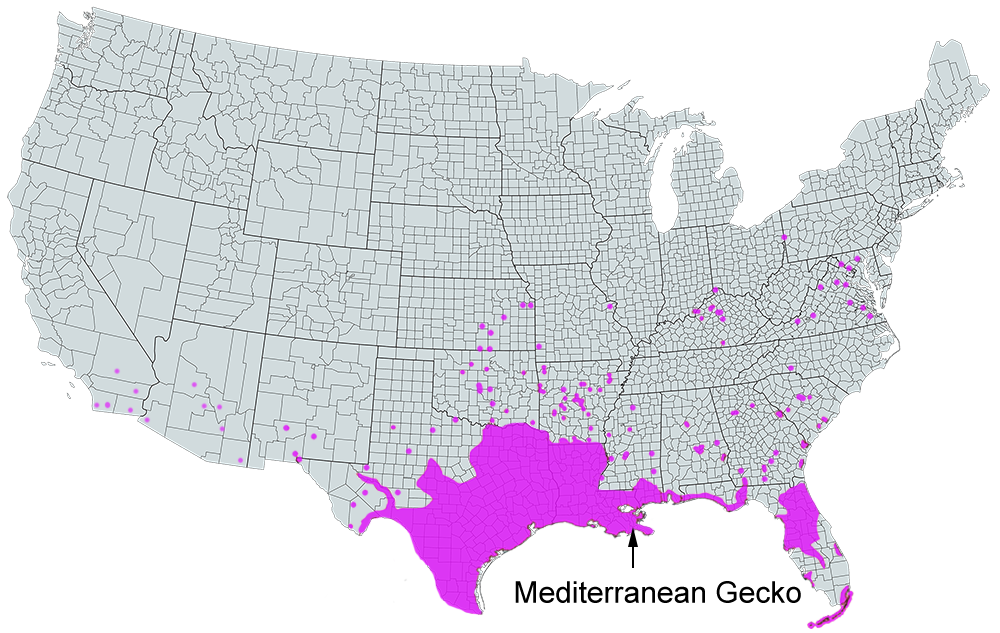Mediterranean Gecko
Hemidactylus turcicus
* Introduced species *
Status and Distribution of the Mediterranean Gecko (Hemidactylus turcicus) in Virginia.
Paul Sattler
Liberty University
Department of Biology
1971 University Blvd.
Lynchburg, VA 24502
Cynthia Lane
Liberty University
Department of Biology
1971 University Blvd.
Lynchburg, VA 24502
Kyle Harris
Liberty High School
100 Liberty Minutemen Drive
Bedford, VA 24523
The Mediterranean Gecko (Hemidactylus turcicus) is native to the Mediterranean area but included on the North American Introduced Species Checklist ) because of its human-mediated dispersal. It was first reported in the United States from Key West, Florida (Fowler, 1915). Meshaka et al. (2006) recently summarized records from Alabama, Arkansas, Florida, Georgia, Louisiana, Mississippi, South Carolina, Texas, and Virginia. Additional records have more recently been reported from these same states and from Arizona (Goodward et al., 2005), California (Beaman et al., 2005), Kansas (Hare, 2006), Missouri (Bufalino, 2004), Nevada (Reed et al., 2006a), New Mexico (Sias and Humhrey, 2002; Murray and Painter, 2003) and Utah (Reed et al., 2006b).
This species disperses readily by human activity (Meshaka et al., 2006). It is hypothesized that eggs are the major but not exclusive life stage being dispersed, often with produce or vegetation. Populations are usually found in the South, associated with masonry buildings and dim lighting where individuals feed on arthropods and seek refuge. Since populations in Louisiana remain active down to ambient temperatures as low as 3.3ºC (Rose and Barbour, 1968), there has been considerable speculation as to how far north the species could potentially spread (Bauer, 2000). Because populations typically occupy heated, inhabited buildings there is a refugia against harsh winter climates.
Recently, Kleopfer et al. (2006) made the claim of reporting both the northernmost and the first record in Virginia for H. turcicus. Actually, their record is the second for Virginia, with Knight (1993) taking precedence describing a population on the campus of Virginia Tech at Blacksburg. Also, the most northerly population to date appears to be one from Baltimore, Maryland (Norden and Norden, 1991), approximately 240 km north of Richmond.
Here we report three additional populations from Virginia, two from the City of Lynchburg and one from nearby Bedford County and comment on its status as an established member of the Virginia herpetofauna. In the late 1990s, Grace Evangelical Free Church moved into a building at 3225 Old Forest Road in Lynchburg. Between 2004 and 2006, eight juvenile H. turcicus were brought to CL from the church. Most were captured on interior walls within the building. One was found crushed to death at the front door. At least one other gecko was found in leaf litter under a board next to the building and another on an exterior wall. Since the majority of individuals were juveniles, and they were captured over a period of two years, we assume this represents a breeding population. Vouchers are deposited in the Liberty University Natural History Museum (# 654-657, 659). The source of the initial introduction is unknown. The building was previously used as a clothing warehouse and distribution center. It is approximately 50 m from another building which was a major chain grocery store 20 years ago, but has been unoccupied since then. Because geckos may be transported in produce, this is a possible source of the introduction. However, they are not known to cross open areas to colonize new buildings. We do not have access to the interior of this other building and the entire area, including all of the buildings, is scheduled to be torn down for new construction in the summer of 2007.
In September of 2006, one of us asked the personnel at Pet and Aquatic Warehouse, a commercial pet store at 2408 Wards Road in Lynchburg if they ever sold Mediterranean Geckos. They responded that they did in the past but not currently, and reported that there was a breeding population in the basement of the building where the humidity from the fish tanks was high and the illumination was low. Juveniles were occasionally captured if there was interest. Upon request, two individuals were produced a week later. One specimen is vouchered in the Liberty University Natural History Museum (# 658) and the other is being maintained in captivity. From this example, one can see how escaped animals from a commercial pet store could establish a thriving population, feeding on escaped crickets according to store employees. This population is at least several years old. It conforms to the typical habitat for Mediterranean Geckos, being a masonry building with low light. This colony, likewise, has a supplemented food supply and high humidity.
One of the authors (KH) recently secured a job teaching Biology at Liberty High School in Bedford County. There, several specimens of H. turcicus were captured in and around the science building during the Fall of 2006. Three individuals were captured inside the building in classrooms. Four more individuals were captured on the outside of the building, two from under a garbage can and two on the wall. Two more individuals were found dead inside the building at a back door and one was found dead inside a storage room. Several of the live specimens are currently in captivity. Other science faculty and the science building custodian have reported sightings in classrooms. Inquiries as to the history of the population from other science instructors indicate that specimens have been observed since the current building was constructed in 1988. A probable source of this colony is escapees from a terrarium. A photo voucher is deposited in the VHS Archive (Digital Voucher # 96) and physical vouchers in the Liberty University Natural History Museum (#661, 662).
We believe that the occurrence of H. turcicus in Virginia is much more widespread than previously thought. This species is capable of inhabiting the remote portions of most buildings, and incidentally dispersed by humans. The Grace Evangelical Free Church has recently moved to a larger building. It will be interesting to see whether Geckos appear in a year or two in their new facility. We encourage Virginia Herpetological Society members to be alert for reports of geckos in their own localities. We have unconfirmed reports of additional sightings at other sites in central Virginia. From our findings and those in the literature, it appears that H. turcicus is an established member of the Virginia herpetofauna, with a final geographic distribution that has yet to be realized.
Acknowledgements:
We thank Steve Roble and an anonymous reviewer for editorial suggestions which greatly improved the manuscript.
Literature Cited:
- Bauer, A.M. 2000. How far north would the gecko move if the gecko could move north? Herpetological Review 31:72-73.
- Beaman, K.R., D.M. Goodward, N.T. Moorhatch, and C.W. Brown. 2005. Geographical Distribution. Hemidactylus turcicus. Herpetological Review 36:79.
- Bufalino, A.P. 2004. Geographical Distribution. Hemidactylus turcicus. Herpetological Review 35:188.
- Fowler, H.W. 1915. Cold-blooded vertebrates from Florida, the West Indies, Costa Rica, and eastern Brazil. Proceedings of the National Academy of Sciences. Philadelphia 67:244-269.
- Goodward, D.M. 2005. Geographical Distribution. Hemidacytlus turcicus. Herpetological Review 36:201.
- Hare, A. 2006. Exoic lizard discovered in Kansas. Journal of Kansas Herpetology 19:9.
- Kleopfer, J.D., S.H. Watson, and J.C. Mitchell. 2006. Geographical Distribution. Hemidactylus turcicus. Herpetological Review 37:106-107.
- Knight, C.M. 1993. A northern range extension of Hemidactylus turcicus in the United States. Dactylus 2:49-50.
- Meshaka, W.E. Jr., S.D. Marshall, J. Boundy, and A.A. Williams. 2006. Status and geographic expansion of the Mediterranean Gecko, Hemidactylus turcicus, in Louisiana: Implications for the southeastern United States. Herpetological Conservation and Biology 1:45-50.
- Murray, I., and C.W. Painter. 2003. Geographical Distribution. Hemidacytlus turcicus. Herpetological Review 34:166.
- Norden, A.W., and B.B. Norden, 1991 [1989]. The Mediterranean Gecko (Hemidactylus turcicus) in Baltimore, Maryland. The Maryland Naturalist 33(3-4) :57-58.
- Reed, R.N., L.J. Trenkamp, B.E. Cox, and S.M. Sorensen. 2006a. Geographical Distribution. Hemidactylus turcicus. Herpetological Review 37:106.
- Reed. R.N. E. Snow, L.J. Trenkamp, B.E. Cox, and S.M. Sorensen. 2006b. Geographical Distribution. Hemidactylus turcicus. Herpetological Review 37:106.
- Rose, F.L. and C.D. Barbour. 1968. Ecology and reproductive cycles of the introduced gecko, Hemidactylus turcicus, in the southern United States. American Midland Naturalist 79:159-168.
- Sias, D.S., and P.E. Humphrey. 2002. Geographical Distribution. Hemidactylus turcicus. Herpetological Review 33:66.
Mediterranean geckos only inhabit urban habitats (i.e. buildings) where there is a stable year-round environment. They have not demonstrated any invasive characteristics, such as displacing a native species or colonizing new habitats and therefore are not a threat to our native wildlife. The VHS is interested in tracking the movements of these geckos in Virginia. Please report any sightings to Paul Sattler
Description: 4 - 5 inches (10 - 12.7 cm) in total length. Most have an overall light or pale coloration, the dorsum is very bumpy with prominent tubercles. The toe pads are broad and extend almost the entire length of the toe.
Habits: Nocturnal, often found perched on walls around outside lights. During the day, these geckos hide in cracks, crevices, and under surface cover.
Prey Items: Include a variety of insects, spiders, and other invertebrates.
Common Name: |
Mediterranean Gecko |
Scientific Name: |
Hemidactylus turcicus |
Etymology: |
|
Genus: |
hemi (Greek) half; daktulos (Greek) a finger or toe; a reference to the clinging pads on the under surface of the toes being divided into two halves, separated longitudinally along the centre line; they are sometimes known, as ‘half-toes’. mabuya (Latin) from an American-Spanish word for a type of lizard. Inhabiting Central America and northern South America and Africa south of the Sahara, including Madagascar. |
Species: |
-icus (Latin) suffix meaning belonging to; it inhabits the eastern Mediterranian coast, the Red Sea area and other pards of the Near East |
Average Length: |
|
Virginia Record Length: |
|
Record length: |
Photos:
*Click on a thumbnail for a larger version.
Verified County/City Occurrence in Virginia
Bedford
Botetourt
Culpeper
Dinwiddie
Fairfax
Hanover
Loudoun
Montgomery
Rockingham
CITIES
Alexandria
Charlottesville
Fredericksburg
Lynchburg
Martinsville
Norfolk
Petersburg
Portsmouth
Richmond
Suffolk
Virginia Beach
Williamsburg
Winchester
Verified in 9 counties and 13 cities.
U.S. Range






